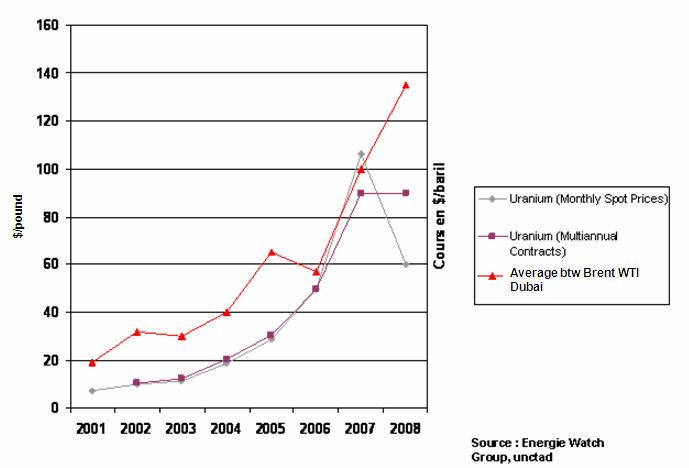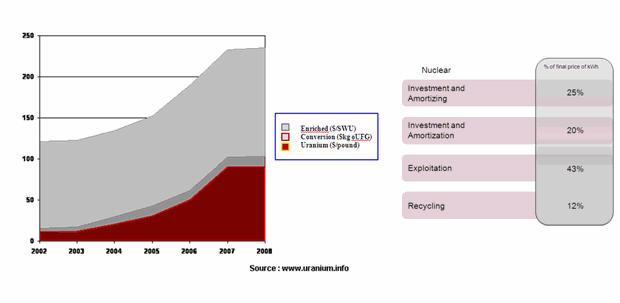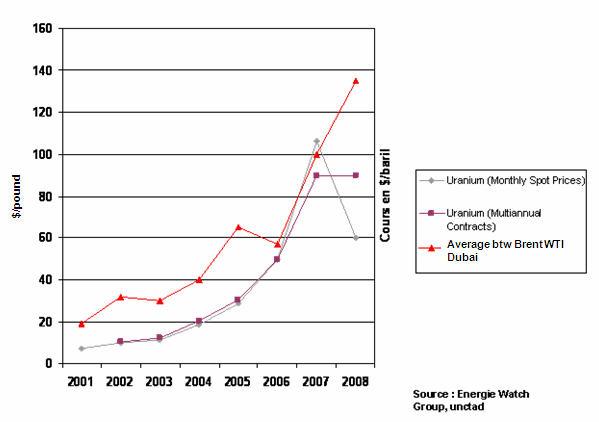Canadian Hydrogen Observatory: Insights to fuel…

As for many other commodities, prices of uranium are skyrocketing. 1000% is the total increase recorded for the last seven years. The pound reached 106 dollars at the end of 2007.
Are there any causes for such a blow-up? Why such a jump for a usually cheap raw material? What are the possible consequences over electricity markets? What are the chances that this trend keeps going on?
Uranium production has been high in the seventies, mostly just after the 1973 oil crisis. Two main reasons can explain this sudden demand:
Couple of years later, demand has dropped. Direct consequence of incidents at Three Mile Island in 1978 and Chernobyl in 1986 is a rapid slow-down in civil nuclear program. Running in parallel and following the dismantlement of Russia, the Soviet-America arms agreement made the military stock not useful anymore. Those stocks were converted into civil nuclear.
Electricity generators that have kept using this fuel have benefit of low costs (less than $10/pound). At the time, it was not rentable at all to invest in exploration and production of this mineral. The activities of all existing excavation ceased one after another.
Structurally, since the end of the eighties, uranium consumption has outperformed the production. Today, 78 000 tons of Uranium Oxyde are produced each year (source WNA): 64% coming from mining, 33% from military and civil stocks and 3% from recycling.
Three elements can be given in order to explain the price increase since 2003:

Figure 1 : Price evolution between offer and demand by 2030
Highlighting those structural issues has led to exceptional stock increase since 2003 (Cf. figure 2) - except if we take into consideration the sudden drop of spot transactions in Q1 2008; indeed, such transactions represent almost 10% of the whole portfolio of utilities. Long term contracts (futures) didn't vary in the meantime. Next to oil and gas, uranium seems to become the next raw material to be expensively valued.

Figure 2: Stock Price evolution (Uranium and Crude Oil (Brent) since 2001)
The €/kWh as the output of a power plant is based on the costs of initial investments, maintenance, fuel and waste treatment.
In the case of a nuclear power plant, initial investments are quite big even though justified on an economical point of view. Indeed, loans are propitious (interests between 5% and 8%) and exploitation rate reaches 80%. The cost of nuclear kWh is way under the one of a classical power plant.
In addition, as the following figures can mention, kWh is almost insensible to the volatility of uranium price:

Figure 3: Cost sharing of nuclear power plant
An increase of 50% in raw material would lead to a minor 5% variation as electricity output. In comparison, the very same increase for gas would have as consequence a 30% variation (cf. figure 4).

Figure 4: Cost evolution in function of fuel
Potential increases for the final client will be very limited if the energy companies do not consent to new investments in nuclear. In most countries, nuclear power plants are getting old. Even France is preparing itself to invest in new generation (EPR). So the price increase has to find other explanations as:
This mineral is also an exhaustive natural resource. The tipping point of this value is subject to many debates. The demand will pretty soon outperform the production. But thanks to the new funds generated via the price, exploration is getting more cash to discover new reserves or exploit non-rentable mines.
- Energy Watch Group
- United Nations Conference on Trade and Development
- World Nuclear Association